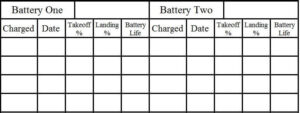An operator bears overall responsibility for the operation of the PLACE Aerial platform, you must follow these guidelines whenever conducting aerial missions.
Adhere to good conduct
As an operator you must observe rules of good conduct:
- You must be in control of the UAV at all times.
- You must be aware of others and know what to do in case of an emergency.
- You must only fly if you have permission and it is safe to do so.
- You should be in a fit state to fly (refer to the IMSAFE checklist)
As an operator you should always take safety and privacy risks to communities into account when planning flights and executing missions.
Take care of equipment
Take care of all equipment making sure it is stored correctly and not liable to damage. Always handle equipment with care. Keep all equipment dry. It is very important that the LiPo batteries are properly maintained. They should be stored in a cool place at “storage” voltage as provided for in the charging options available on the chargers. Consider placing the batteries in a fireproof-container.
Keep equipment of out direct sunlight
Keep all equipment out of direct sunlight as high temperatures can damage the UAV’s electronics and adversely affect the LiPo batteries.
Track battery hours
Record the date and duration each battery was used for, the take-off and landing percentage and the health reading as given by the app you are using. A suggested proforma is shown below:

Complete training
Although virtually no manual inputs are required for the execution of an automated image acquisition flight as an operator you must have a good understanding of the various phases of the flight so that if necessary you can make informed decisions before interfering manually during an automated flight.
Before flying you should ensure you have completed country specific civil aviation training and are certified for fly for commercial purposes.
You should also complete the “Unmanned fixed wing aerial image acquisition using PLACE Aerial” course (see the section Training for more details).
Upon completion of the course, operators will be issued a certificate of completion, providing proof of training and meeting any continuous professional education (CPD) requirements. As long operators fly regularly (at least once a month) there is generally little need for remedial training, it can be provided, however should an operator fall under these currency requirements.
Comply with regulations
You must ensure compliance with all relevant requirements and authorizations. For current regulations visit the Global Drones Regulation Database and check with your country’s Civil Aviation Authority (CAA).
Drone regulations vary widely around the world. Some countries permit beyond visual line of sight flight operations, while others do not. Some have authorization processes for BVLOS flight. Contact your country’s aviation authorities for relevant information.
Most countries restrict drone operations to a certain altitude, typically this is 120m/400ft. Some countries restrict drone flight over people, moving vehicles, or other infrastructure. Some countries also have special regulations related to flying at night. Contact your country’s aviation authorities for further information, and methods for securing legal exemptions to these policies (if they are available).
You must be aware of local no fly zones. They may include controlled and/or prohibited airspace around airfields, airports, infrastructure facilities, prisons, and military installations, among other locations. No Fly Zones and areas restricted to UAV flight vary widely from country to country. It is the operators responsibility to know where these are.
Inform ATC
You must notify air traffic control (ATC) on where and when you are conducting aerial operations so Notice to Airmen (NOTAMs) can be issued. Once in the field you should keep ATC informed of your activities (e.g. when the UAV has been launched, when it has landed and you have cleared airspace).
Take out insurance
You must have appropriate insurance in case of loss or damage to the UAV. International insurance brokers include droneinsurance.com.
Log flight hours
All operators should log their flight hours to ensure they maintain proficiency. At a minimum operators should ensure that they have completed at least three take-offs and landings with the UAV platform they intend to use within the last 90 days.
A number of software solutions exist for tracking flight hours as well as other aspects of drone flight. They are commonly known as Flight Management Systems (FMS). Operators should investigate these programs and determine which one works best for them.
Report incidents
Should you have an accident, damaging either the UAV or property, injure yourself or others, you should report the incident to the relevant body in the country you are working in. You should also notify PLACE, via email, within 24 hours.
Collect and Handle Data Responsibly
Drone data is of a very high resolution and may capture personally identifiable information (PII) or demographically identifiable information (DII) that could put people and property at risk. Privacy risks to individuals and to groups on the ground must be taken into account during flight planning and image acquisition, this may include not overflying certain areas. Some countries have specific regulations pertaining to drone data collection, or to the collection of aerial imagery in general so check with your CAA. Operators should research in advance and work with legal advisors/the Government to ensure they are in compliance with relevant laws. If required community members should be informed of impending drone flights and a person should be designated to answer community member questions if they arise while flights are in progress.
As an operator you will handle sensitive image, there you must:
- Store images on encrypted storage devices during transfer or transit o
- Data must be only be handled by authorized, only approved individuals should be given access to the data to process or upload it.
- Delete all image data from your own drives and storage locations after it has been accepted for admission into the PLACE Trust.
